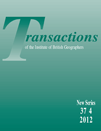Transactions of the Institute of British Geographers vritual issue on GIScience
Since early 2010, I had the privilege of being a member of the editorial board of the journal Transactions of the Institute of British Geographers . It is a fascinating position, as the journal covers a wide range of topics in geography, and is also recognised as one of the top journals in the field and therefore the submissions are usually of high quality. Over the past 3 years, I was following a range of papers that deal with various aspects of Geographic Information Science (GIScience) from submission to publication either as a reviewer or as associate editor. 
In early 2011, I agreed to coordinate a virtual issue on GIScience. The virtual issue is a collection of papers from the archives of the journal, demonstrating the breadth of coverage and the development of GIScience within the discipline of geography over the years. The virtual issues provide free access to a group of papers for a period of a year, so they can be used for teaching and research.
Editing the virtual issue was a very interesting task – I was exploring the archives of the journal, going back to papers that appeared in the 1950s and 1960s. When looking for papers that are relevant to GIScience, I came across various papers that relate to geography’s ‘Quantitative Revolution‘. The evolution of use of computers in geography and later on the applications of GIS is covered in many papers, so the selection was a challenge. Luckily, another member of the editorial board, Brian Lees, is also well versed in GIScience as the editor of the International Journal of GIScience. Together, we made the selection of the papers that are included in the issue. Other papers are not part of the virtual issue but are valuable further reading.
To accompany the virtual issue, I have written a short piece, focusing on the nature of GIScience in geography. The piece is titled “Geographic Information Science: tribe, badge and sub-discipline” and is exploring how the latest developments in technology and practice are integrated and resisted by the core group of people who are active GIScience researchers in geography.
You can access the virtual issue on Wiley-Blackwell online library and you will find papers from 1965 to today, with links to further papers that are relevant but not free for access. The list of authors is impressive, including many names that are associated with the development of GIScience over the years from Torstan Hägerstrand or David Rhind to current researchers such as Sarah Elwood, Agnieszka Leszczynski or Matt Zook.
The virtual issue will be officially launched (and was timed to coincide with) at the GIScience 2012 conference.
As I cannot attend the conference, and as my paper mentioned the Twitter-based GeoWebChat (see http://mappingmashups.net/geowebchat/) which is coordinated by Alan McConchie, I am planning to use this medium for running a #geowebchat that is dedicated to the virtual issue on the 18th September 2012, at 4pm EDT, 9pm BST so those who attend the conference can join at the end of the workshops day.
